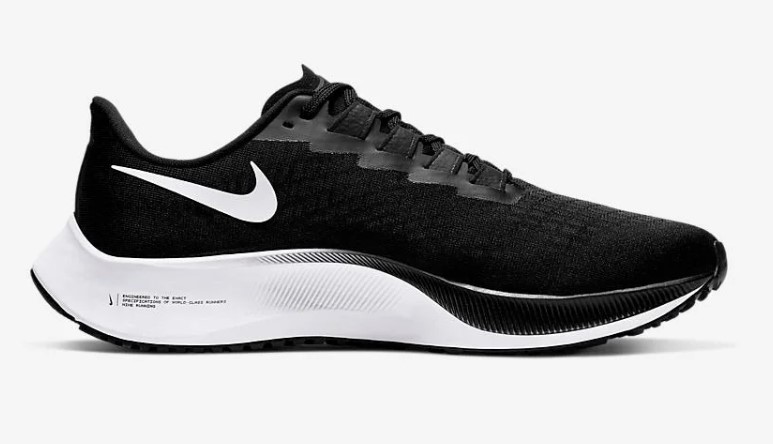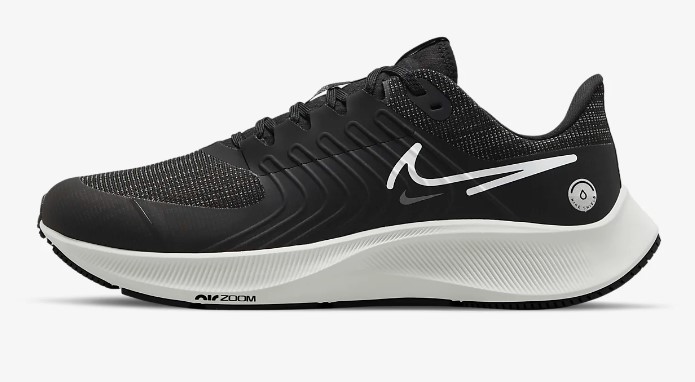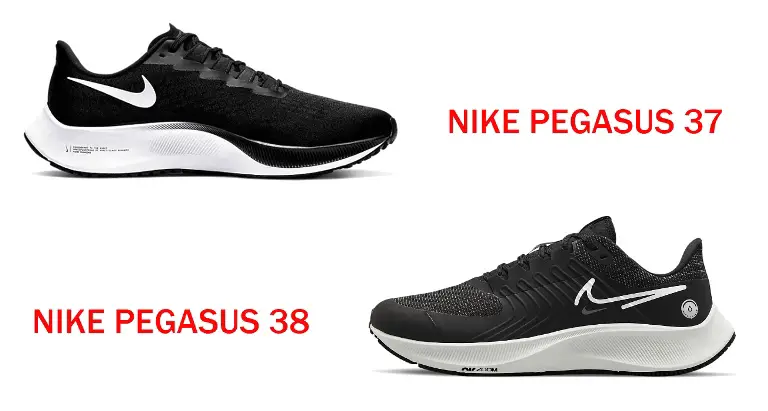Blog
Nike Pegasus 37 vs 38 – Which Is Better?
Nike has a wide variety of running shoe models, but the Nike Pegasus lineage ranks among the best options with nearly 40 models. Of the two latest Pegs, Nike Pegasus 37 vs 38, which one is better for your running distance and style?
Let’s take a detailed comparison of these two Nike sneakers.
Contents
Nike Pegasus 37 vs 38: An overview
Nike Pegasus 37
Specs:
- Heel drop: 10mm
- Weight: 250gr
- Width: Standard
- Damping: alto
- Surface: asphalt
- Distance: 10K, medium-marathon, marathon

Some highlights in the Pegasus 37:
Nike Air Zoom Pegasus 37 was released on April 28, 2020, and included many upgrades versus its previous iteration, Pegasus 36.
Instead of using cushioning foam like in the previous Nike Pegasus generations, the Pegasus 37 is the first one to use the Nike React foam for a lighter feeling, higher bounceback, and greater durability.
Second, the double-thickness Zoom airbag is placed differently in the men’s and women’s versions, resulting in excellent energy return, and pushing the runner forward with less effort.
And last but not least, the lightweight, breathable mesh upper maintains fresh air inside the shoes and keeps your feet odor-free.
The Nike Pegasus 37 offers you various creative colorways and color schemes.
For example, the ‘Splatter Paint’ colorway is available in Black, White, Multi-Color, and Flash Crimson. On the other hand, the ‘Double Swooshes’ colorway is available in Pink Blast, Barely Rose, Bright Spruce, and Atomic Pink.
Nike Pegasus 38
Specs:
- Heel drop: 10mm
- Weight: 291gr
- Daping: neutral high
- Surface: asphalt
- Distance: short, 10K, medium-marathon, marathon

Some highlights in the Pegasus 38:
Nike Air Zoom Pegasus 38 first debuted on April 21, 2021. This Peg version has a similar look to the Peg 37 but includes many improvements, including a roomier toebox, a lower Air unit for the women’s version (15 PSI version 20 PSI), and an extra 2mm in the underfoot.
Whether you are addicted to daily miles or long runs, the Peg 38 won’t disappoint you!
Additionally, there is also a no-lace FlyEase version in the Peg 38. This version hit offline retailers and the “Nike By You” program along with the release of the Peg 38.
Similarities Between Nike Pegasus 37 And 38
Since the Nike Pegasus 38 is the upgraded version of the 37, these two sneakers share some common characteristics:
Zoom Air unit
The Pegasus 37 and 38 share the same midsole, with a Zoom airbag and a heel drop of 10mm. Bulky as it might seem, this airbag is soft, responsive, and lightweight.
React foam
There is full-length React foam in the midsole area, providing ultimate support from heel to toe.
The React foam first appeared on the Peg 37 as a replacement for the traditional rubber foam, providing more bounceback and support underfoot.
However, this React foam is not as springy as the Nike ZoomX foam in the Nike Vaporfly and the Nike ZoomX Invincible Run. It is also not as soft as the Joyride Run Flyknit.
Removable insole
These two Pegs have a removable insole, just like other models of Nike (for example Nike Air Max). This insole lets you pull it out, clean it up easier, and let it air-dry before putting it back in the shoe.
Moreover, this insole has firm cushioning, adding extra softness and comfort to your run experience.
Rubber outsole designed for your natural movements
On the medial side, there are waffle grooves to protect the soft React foam while improving the traction when running on wet/uneven terrains.
On the lateral side (or the crash zone), there are blown rubber patterns to soften the impact of your footstrike while providing a smoother rearfoot landing. This outsole design has appeared on previous Pegasus versions, from the Pegasus 31.
Nike FlyWires
Instead of using traditional laces, the Pegasus 37 and 38 use the FlyWires appear again to minimize the weight on the upper area while maximizing support and security for your overall feet.
These laces are made of Vectran – a lightweight yet strong fabric that is also used in bicycle tires. This fabric is 5 times stronger than steel yet thinner than human hair. They are placed in the key areas on your feet’ upper to avoid the feet from slipping while keeping them stay secured on every stride.
Available in wide and extra-wide options
Both the Peg 37 and 38 are available in wide and extra wide options, which is a great advantage for runners with wide feet.
What Are The Differences Between Nike Pegasus 37 And 38?
Design & Fit
The Peg 38 fits more comfortably than the 37.
In terms of sizing, the Peg 38 runs larger than previous Nike Pegasus models and other Nike shoes. On the other hand, the Peg 37 runs true to size with a narrow upper.
So, you should choose at least 0.5 sizes down with the 38 but pick up your current shoe size with the 37.
While their general fits stay the same, there is more room in the toe box area than in the 37. Although these Nike sneakers share the same React Foam, the Peg 38 offers more foam than the 37 and 36.
Moreover, the Peg 38 maintains a lockdown feeling not only in the midfoot area but also from heel to toe.
Upper
Another noticeable upgrade between Nike Pegasus 37 and 38 is the shoe’s upper. The upper of the Peg 38 is softer like a sandwich, while that of the Peg 37 is firmer.
However, there are several mesh layers on the upper, making the underfoot a bit warm. Yet, at the end of the day, this sneaker is still comfortable and flexible and you won’t feel any restriction in movement.
Midsole
These 2 sneakers share the same React foam in the midsole area. However, the air pressure in the air unit of Peg 38 for women is lower than that for men (PSI 15 versus PSI 20).
This adjustment better matches the gait patterns and comfort requirements of female runners, resulting in a softer, easygoing experience.
Plus, the React foam in the Peg 38 is firmer with higher density than that in Peg 37.
Eyelet chain
Both Pegasus 37 and 38 use the FlyWires, but the laces on the latter are softer and secure your feet better.
While the laces on the Peg 37 are made of faux leather or plastic, those on the Peg 38 are made of cloth and they are softer and stronger.
The laces on the Peg 38 are secured on one side of the shoe’s upper and the midsole and wrapped around your foot.
Plus, there is an extra eyelet along with the eyelet chain. You can use this free extra eyelet to make a knot on your shoes, which is optional.
Tongue
The tongue on the Pegasus 38 has more padding than in its previous one. Although this extra padding adds a little weight to the shoe, it protects your foot’s upper from touching the laces.
Plus, there are insulated, waterproof ¾ gussets to keep moisture and cold out.
Heel counter
There is a minor tweak in the heel counter between these two Nike Pegasus versions.
On model 38, there is an Achilles heel flare to hug and keep your heel in one place. Although this heel counter design isn’t as that on stability shoes, it still keeps your feet comfortable while running.
Check more: Asics Kayano vs Nimbus Comparison – Which Is Better?
Who Should Wear Nike Pegasus?
The Nike Pegasus is a great choice for runners of all levels and running styles. Whether you are a beginner or an advanced runner, these Nike shoes can satisfy your requirements.
They provide a natural and smooth transition from heel to toe following your gait cycle. If you are a heel striker, the Pegasus will work great for you. Its nice heel bevel offers a soft, responsive, and cushioned transition from heel to toe.
However, the Nike Pegasus is not the most lightweight trainer shoe (the Peg 37 weighs 250gr, the Peg 38 weighs 291gr, while the Hoka Clifton 7 weighs only 242gr). You should only use this sneaker for running your first 5K/10K or for easy daily runs.
Final Verdict: Which One To Buy?
In sum, the Nike Pegasus 37 and 38 have some similarities, including the gender-specific Zoom Air unit, the React foam, the removable insole, and FlyWires.
However, the Peg 38 is roomier in the toebox, slightly more comfortable, and has a deeper heel cup than its previous Peg 37.
The latest Peg, Nike Pegasus 39, is true to size despite its bulky look.
Yet, you should choose Peg 37 if you love the Pegasus or only use your shoes for long runs. On the other hand, choose the Peg 38 if you plan to use your shoes for short and long runs or prefer running shoes with more designs and a spacious fit.

